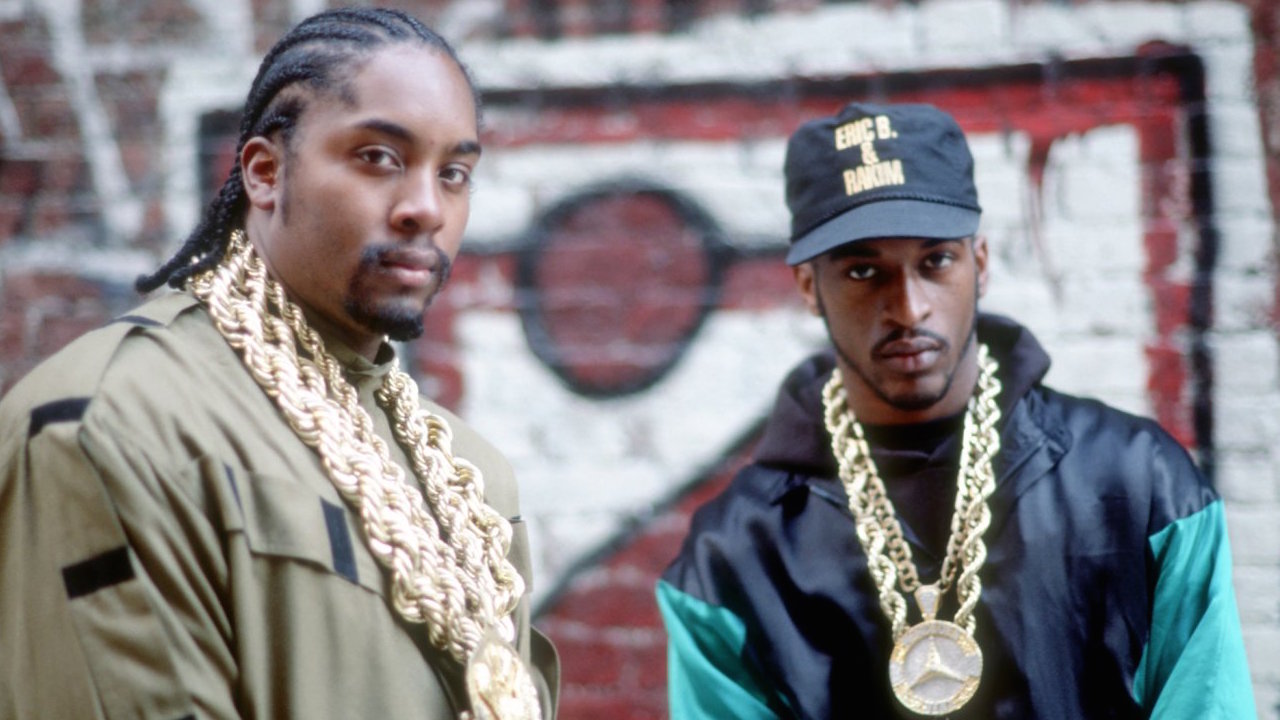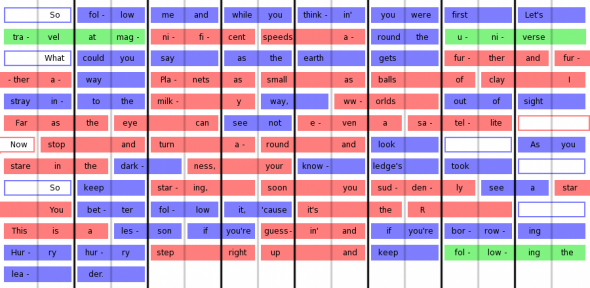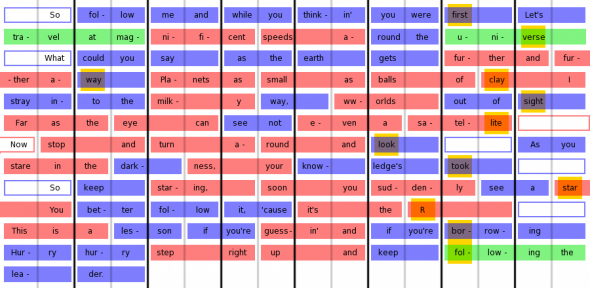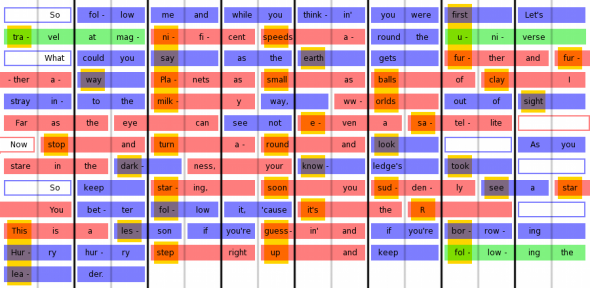This post is a follow-up to Episode 205 of the Theory For Turntables podcast, where we talked about the Eric B. and Rakim albums Paid in Full (1987) and Follow the Leader (1988). So of course you’ll want to go listen to that if you haven’t already — but it can also stand on its own, so if you have some insane grudge against awesome podcasts and cross-platform content synergy, feel free not to click the link.
Ryan and I spent most of that podcast trying to articulate what exactly it is that makes Rakim such a good rapper. That he’s historically important is easy to establish — you just have to point to everyone else pointing to how important he is. But it’s harder to articulate what actually makes him good. On the podcast, I talked about the way that he uses shifting groups of two and three syllables — this is still basically right, I think, but it didn’t come across all that clearly. I ended up just reading off a big string of twos and threes: “But then he goes two two, three two, three three two,” etc. Not super informative. So I got to thinking: is there a better way to explain this?
Another thing that came up on the podcast is the fact that Rakim has been badly served by Genius.com. Not that they’re getting his lyrics wrong, or anything — it’s just that the gap between the text on the page and the performance of that text is huge, yuuge for Rakim. Isn’t there some better way to transcribe rap lyrics?
Ideally what I’m looking for is a way to explain the rhythmic intricacy of this music to people who have no prior musical training. I emphatically am NOT trying to “prove that rap music is worthy of serious scrutiny,” or “expose the hidden brilliance of Rakim’s lyrics,” or any such nonsense. Rakim’s brilliance isn’t hidden. It’s right there in the music itself: if you ever need to convince somebody that Rakim is brilliant, staple some decent headphones to their heretic ears and play “Follow the Leader” on loop until they see the error of their ways. And rap music as a whole is doing just fine without me riding in to defend its honor with the sword of my analytical rigor and the shield of my general white-dudery. But I do think there’s a value to trying to understand Rakim’s brilliance… and that’s where this post can maybe help.
First, some preliminaries. What we’re looking for is a way to indicate patterns of stressed syllables. The basic concept I seized on is the highlighter pen — although this being the digital age, of course, I used photoshop (and me being a cheapskate, I actually used GIMP). Take for example the mnemonic, “In fourteen hundred and ninety two, Columbus sailed the ocean blue.” To begin with, let’s just highlight the stressed syllables. We don’t even need a highlighter for this:
“In fourteen hundred and ninety two, Columbus sailed the ocean blue.”
So far so good. But — and this is why I think Genius.com is so bad at conveying what matters about rap songs — this doesn’t tell us anything about the way the way these words move through time when you perform them. So let’s try again: this time we’ll space the phrase across a grid, where each box is about the duration of that initial “in.” If you want to be technical about it, each box of the grid contains one mora.

Now we’re getting somewhere. Each red box is a group of three morae — three ticks of the clock, as it were — of which the first is a stressed syllable. Notice that there’s a box containing the last two syllables of the first line and the first syllable of the second line, which is spread across two rows of the chart.
To talk about “Follow the Leader,” we also need a way to reference groups of two and four syllables. We’ll use blue and green respectively, like so:

Why two and four? Why not just split “Have you any” into two blue boxes? Remember that the first syllable in any box is supposed to be stressed. I don’t hear a stress on the a in “any.” In the big graphic, below, I only use green boxes in places where two blue boxes wouldn’t work. (Typically these either feel like an unbreakable unit of four, or like a 3+1 structure with a tight unit of three and one extra unstressed syllable at the end.) The empty blue box at the end of the phrase indicates that there isn’t a stressed syllable here. Obviously you use these when there’s a pause, but you could also sometimes use them in other contexts.
That covers pretty much everything. Ready to move on to the advanced material? Let’s look at the last twelve lines of the first verse of “Follow the Leader,” from the album of the same name.
Even leaving the patterns of stress out of it entirely, there’s already something kind of remarkable here. Look at how the poetic lines are splayed across musical time. Each row of the table takes up one full cycle of Eric B.’s throbbing bassline, and roughly one poetic line. But five of the twelve lines either start early or lag over, and three more are a full bar short (fitting into 12 squares or less). So in this passage at least, the poetry lines up exactly with the music less than half of the time. And then look at the pattern of sonic presence and absence: think of every syllable as a one, and every blank space as a zero. Each of these twelve lines has its own unique pattern: Rakim never repeats his rhythm. Even if you break it down to half-lines (considering “So follow me and while you” and “thinkin’ you were first/ Let’s” as separate shorter units), it turns out that more than half of them are unique.
Take special note of line five, where I’ve written the lyrics “ww-orlds out of sight.” This was the hardest line to transcribe: I actually had to listen to the music at half tempo before I figured out what was happening. Rakim sort of smears the word “world” over the two beats here: he starts to pronounce the consonant in one mora, but doesn’t voice the vowel until the following mora. He does this a few times in the song: you can hear another one right at the beginning, when he says “follow me into a solo,” which is actually more like “follow me into a ss-olo.” Anyway, for the purposes of this section of the post, I wasn’t sure whether to count the “ww-” part as a sound or a silence… but it turns out it doesn’t matter: either way you slice it, every line is completely unique.
Now let’s add the highlighter.
If you want to get the most out of this, go ahead and listen to the song while looking at this diagram and counting out the rhythms under your breath. (So for the second line you’d say “One-tw0-three-four One-two-three One-two-three One-two One-two-three-four,” and so on. Hard, right? But it’ll get you closer to the music.
Here again, the patterns never repeat. (Think of the first line as 22222222, the second as 43324, etc.) There is one near miss: look at line two, “travel at magnificent speeds around the universe,” and line twelve, “Hurry, hurry, step right up and keep following the”. If you forced yourself to replace those groups of four syllables with two groups of two (which is how I initially planned to approach this), these would look identical. But they don’t sound identical: the beginning of line two, “travel at mag-” and the end of line twelve, “following the” are both cases where I hear the four-mora block as a tight-knit group of three followed by a loosely affiliated garbage syllable. The same doesn’t apply to their opposite numbers.
Take a moment to look at a few particularly ballsy passages: lines 3-4 and 9-10, where three-mora blocks span across two rows of the table; and the offset syncopation of the syllables “way” and “dark” in lines 5 and 8. You’ll have noticed that the vertical lines alternate between black and light grey: these correspond to beats and off-beats on the backing track. Whenever one of these blocks starts with a grey line (which is pretty often, especially in those big chains of red blocks), that means we’re getting a strong syllable on the offbeat, which means it’s intensely syncopated.
But we can go deeper. Let’s add another layer of color to the table:
The yellow boxes highlight the rhyme words. (Rakim is famously a master of internal rhyme, but here I’m focusing on the rhymes that fall at the ends of the lines as reported on Genius.) As you can see, these fall all over the place, and never fall on the same beat twice in a row except for the last two lines of the verse, where it almost functions as a sign-off. If you just look at a transcription of the lyrics on Genius.com, you’ll never notice this. But maybe that’s sort of the point. Genius treats all the lyrics as if they were poetry — and this aspect of rhythmic play is not really a feature of poetry that doesn’t have a backing track.
What I like about this way of examining the lyrics is that you can experiment with highlighting different features. (If you’re doing it in photoshop, it’s as easy as adding a new layer.) So here’s what happens if we ignore the rhyme scheme and just highlight the syllables that — to my ear — Rakim stresses particularly hard.
Again, variety is the name of the game. But what’s interesting — and perhaps surprising, at this point — is that here we see a definite underlying pattern. Look at those big columns of yellow on the 5th, 8th, 11th, and 13th columns of the grid. The clusters on the 5th and 13th columns are particularly interesting, because this these correspond to the standard back-beat that pretty much all pop, rock, and rap songs are based on. As long as Rakim keeps hitting these hard with some kind of regularity, the rest of the rhythmic variety will sort of come out in the wash: it’ll sound hardcore, but not alienating. This also throws some interesting light on the displacement of the rhyme words. Look at “universe” in line 2: “-verse” rhymes with “first,” so the rhyme words are displaced… but “-verse” is a weak syllable. The stressed syllable in that word, “un-,” falls right where “-verse” is supposed to go. (You can imagine a less interesting, non-displaced version of the line where Rakim says “Let’s travel at magnificent speeds, the universe.”) Also interesting is the 8th column, which is the only off-beat to get this kind of regular stress. Metrically, this position is very weak. By making it sonically strong, over and over again, Rakim keeps the surface of the music percolating: if all that he did was stress that syllable in every line, it would still sound like this was rhythmically sophisticated music.
And of course, all of this is still only scratching the surface. Here’s a short list of important elements that I haven’t even touched on:
• The way Rakim’s lyrics interact with the actual sonic features of Eric B.’s beat.
• The way these rhythmic features interact with the meaning of the lyrics.
• Alliteration. (“Soon, you’ll Suddenly See a Star,” and so on.)
• Internal rhyme. (Check out lines 3-5, where the pattern of rhymes is ABBACCA: say/earth/furth-/-way/small/ball/clay.)
• Connections to other musical traditions. (I haven’t done the research yet, but I’ll wager you dollars to donuts that Rakim is basically channeling techniques from bebop drumming.)
And I could probably go on. But this analytical method is a work in progress, and I’m curious what you all think of it. Overall: does this help you understand the song better? What features of the song should I be tracking that I left out in this analysis? What other songs do you want to see put through this mill? Hurry hurry, step right up, and leave your answer in the comments.





You know that Rakim’s actually been annotating some of his own tracks on Genius, right?
http://genius.com/Rakim777
WELL HE’S NOT DOING A VERY GOOD JOB
But seriously: I guess this comes across as a big attack on Genius, but it’s not really intended as one. It’s just an attempt to explore an aspect of the music that Genius is not set up to account for — even if the annotator is Rakim himself.
RAKIM is a lyrical genius!….. We don’t even need a chart on emphasis and syncopation to ascertain this. Just his use of play on words, phrases, the way he can convey emphasis with words, slang on a subject… Just listened to “know the Ledge”again in 2020!Enjoying that you know that he is a genius as well as myself. Rakim and Eric B for President in 2020!